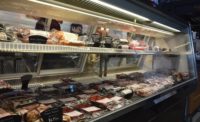Glier's Goettafest
A festival to honor one of Cincinnati's favorite foods is a four-day celebration of all things goetta.










Take a map of Ohio and put a pin in the middle of Cincinnati. Next, draw a circle that encompasses a 25-mile radius around that pin. What you have within that circle is about 90 percent of the population who knows what goetta sausage is. That may not seem like much, but the people within that radius love goetta. They love it so much that they tell their friends and family from out of state about it. They love it so much that they’ll eat it in a variety of forms and flavors. And when there is a festival dedicated to this specialty sausage, they come by the hundreds of thousands to celebrate a Cincinnati specialty.
Glier’s Meats may be headquartered in Covington, Ky., just across the Ohio River from the city formerly known as Porkopolis, but it’s just as much of a Cincinnati institution as its famous products. The company got its start in 1946, and while it makes a variety of products, from hams to brats and metts, goetta is the most renowned of its products. Glier’s offers it in chubs, slices, slabs and links, in original, hot, turkey and bacon varieties. All total, there are about 10 goetta products that Glier’s produces regularly.
Then there is the festival. Each August, Glier’s takes over Northern Kentucky’s Newport on the Levee park for a four-day festival called Goettafest. The festival, which attracts more than 200,000 people, features game booths, two music stages, drinks, a children’s play area and, of course, goetta. Some of Cincinnati’s best restaurants offer up tasty meals and treats for the crowds, and goetta is more often than not a featured ingredient. Burgers, bangers, pizza, spring rolls and more are goetta-fied, and attendees can’t get enough. Goettafest has become Cincinnati’s third-largest festival, behind only the Taste of Cincinnati and Oktoberfest.
Dan Glier, president of the three-generation business, has tried almost all of the entrees, from goetta burgers to deep-fried goetta balls. He says that he puts them into three categories.
“We have our normal food, we have our adventuresome eating food, and what I call outer limits food,” he says. “So in my normal food, I like goetta grilled cheese, I like goetta mac and cheese. I like goetta spring roll, or goetta fried rice, which could be adventuresome, but it is one of my favorites. Then it goes out from there. I mean, goetta fudge! That’s a little bit on the edge.”
Just what is goetta?
Glier’s has been in business since 1946. Glier’s father, Robert, was a returning World War II veteran who opened up a small butcher shop in Covington. After 20 years, the business had grown to the point that it needed a larger space, so he bought a part of the old Bavarian Brewing complex in Covington and moved operations there. The building dates back to the 1880s.
Robert Glier produced goetta in the winter months as a breakfast sausage. Thanks to its popularity and the Glier family’s ingenuity, it’s now a staple for every meal occasion.
For the uninitiated, a little explanation may be in order. Goetta’s history goes back to Germany when farm animals were slaughtered at home. The trimmings, too valuable to be just thrown away, were ground into sausage.
“Of course, on a farm, you wanted to have a sturdy, hearty meal to start your day,” Glier explains. “So you added grains to extend the meat and provide you with food for the day.”
Goetta uses pork and beef, as well as steel-cut oats and seasoning. Glier’s still produces it in the old-fashioned methods, and Glier himself patented the double-boiler cooking system that reduced the amount of water used and the heat released by the process.
Glier’s goetta, and its other products, are distributed throughout Cincinnati grocery and club stores and foodservice channels. People who live outside of its distribution area can find goetta at www.cincyfavorites.com, where many of the city’s iconic food brands are available for shipping.
Goetta’s popularity is spreading further and further, too.
“There’s a spiderweb that goes out,” Glier explains. “We’ve got some people in Columbus. We’ve got a few people in Indiana. We’ve got Louisville and Lexington. Our transplants — say for example the kids that go to Ohio State, or University of Kentucky or University of Louisville — they’ve had goetta and want goetta so they come home, bring it and take it up and introduce it to their friends.”
Whether they grew up eating goetta or were introduced to it later, sooner or later all fans have to go to Cincinnati for Goettafest. It’s become a worldwide attraction, and that is not an overstatement. One of the displays at the festival is a series of state, national and international maps, and visitors are invited to put a pin into the place where they are from.
“Last year, we had pins in all 50 states, and we had pins in 123 countries,” Glier says.
The festival, which this year celebrated its 18th year, has become a family affair. Glier recalls that he saw a large family sitting at a table one year, so he asked what brought them to the festival.
“It turns out this is a four-generation family, from toddlers up to great grandparents, and it was their 50th wedding anniversary. And the kids asked mom and dad, ‘Well, what do you want to do for your 50th? It’s important.’ And they said, ‘Well, you know, the whole family loves goetta. Why don’t we go to the Goetta Festival for our anniversary?’
“That says a lot for goetta. It really does,” he adds.
Preparing for Goettafest
Preparation for the 2018 Goettafest started about a week after the 2017 festival concluded. Then Glier, his son David, and other members of the team came together with notes on how to improve it.
“Our goal is to have at least one major improvement every year, and then tweak, tweak, tweak. We’ve had as many as 60, but we’re down to 30 or 40 tweaks,” Glier says.
This year, upgraded portable toilets were added so that visitors had a restroom choice besides the standard portables. In addition, the drink vendors were placed on the river side of the park, so that the runoff from melting ice would flow down a grassy hill toward the Ohio River rather than across the walkway. A tweak like that might be something that visitors wouldn’t notice, but they would notice if they spent their time splashing through puddles and getting their feet wet.
Small but common-sense improvements to the festival indicate the attention to detail that Glier and his team have for the festival. Goettafest is, for instance, the only outdoor festival in Cincinnati that has air-conditioned food tents — an ideal place to enjoy a goetta Rueben on a hot summer day.
“I have as much air conditioning and refrigeration [at the festival] as I do in my plant,” Glier remarks. “It’s expensive, let me tell you, to run that thing, but it’s worthwhile because people can go and they can spend time.”
As an added bonus, festival-goers are more likely to order more food knowing that there are cool places to sit down and enjoy a meal.
As the show is meant to be a family event, the children’s area was expanded for this year’s festival as well. The prizes for the games were improved as well.
“I don’t need a purple tutu for a prize, but I’m sure somebody wants one,” Glier jokes.
Along with the games, there are many other entertainment options. On either side of the event, there are stages where bands play throughout the event. Visitors to the festival can sit and listen to music into the evening, with a beautiful view of Cincinnati’s skyline behind them.
Of course, Goettafest would be nothing without goetta. There are tents detailing the facts about goetta and the history of Glier’s. There is a merchandise tent where festival-goers can buy everything from Glier’s T-shirts to stuffed Mr. Goetta toys (the company’s mascot). Above all, there are the food stands.
Glier’s produces about a truckload of food to provide for all of the food stands. All the varieties of goetta that Glier’s offers come into play, depending on their needs.
“Some of them want patties, some of them want links, some of them want bacon goetta, some of them want hot slab goetta. We box them up, and it’s put on a truck with their name on it,” he says.
This year’s event had about 50 different goetta creations, he said. Creativity has to be used, because booths are not allowed to overlap their offerings. If one booth has a goetta dog or goetta pizza, no other booth is allowed to have them.
Goettafest has come a long way from its origins. When Glier’s launched its initial Goettafest, it was done as a simple thank-you to its customers and was located in Covington. It was a one-day event, there were only six food vendors, and Glier anticipated that about 3,000 people would show up. As it turns out, 5,000 goetta lovers came, and the food booths ran out of goetta. Fortunately, Glier says, a rain shower in the middle of the day drove attendees under the tent.
“We were able to run back to the plant and restock all of our vendors,” he says.
Goettafest today has 13 different food vendors and takes place over four days. Glier explains that when the festival was three days, the local news networks would arrive on Friday to tape footage and then air it on the Saturday morning news. By starting Goettafest on a Thursday, the news crews show up and air the footage on the Friday morning news, reaching a larger audience.
During the course of Goettafest, the Glier’s plant closes down. The employees work the festival, and Glier says that he puts in a 40-hour week after his 40-hour week. Along with checking in with the business, he will be at the Levee before, during and after the festival, ensuring that everything is running smoothly.
Proceeds from Goettafest games are given to charity. For this year’s event, Glier’s partnered with The Dragonfly Foundation (www.dragonfly.org), which lends assistance for pediatric cancer patients and their families. Cincinnati’s Children’s Hospital Medical Center is one of the leading children’s hospitals in the country. Oftentimes, on a sudden serious diagnosis, families arrive at Children’s with nothing more than the clothes on their backs.
“Dragonfly provides some entertainment with games and toys for the kids, and they also support the family by providing with them with something as simple as a credit card that works in the vending machines and a kit that has toothpaste and toiletries and things that are not available in the hospital. It’s a need that has not been met prior to this,” Glier says.
Glier’s has a long history of community service. One of the walls by the offices is covered with plaques and certificates that have been presented to the company. Glier’s participates in between six to 10 parades a year and even has a calliope that it brings along. When the crowd hears the calliope they know that David Glier soon will be racing down the parade route on a Segway, handing out free goetta.
For Glier, charity is a natural extension of running a business.
“I’m a Christian, unabashedly so,” he says. “And part of your Christian responsibility as a business owner is to be in your community as part of the community. We have our charities, and that’s where we come from.”
Looking for a reprint of this article?
From high-res PDFs to custom plaques, order your copy today!











